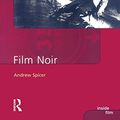
Film Noir
Andrew Spicer
"Yes, I killed him. I killed him for the money and for a woman. I didn't get the money, and I didn't get the woman. Pretty, isn't it?" -- Fred MacMurray in Double Indemnity, 1944 An examination of 'classic' film noir (1940-59) which explores its contexts of production and reception, its visual style, narrative patterns and themes and character development. Traces the complex development of 'neo-noir' from Night Moves and Taxi Drive to Pulp Fictionand Momento. Is an accessible, informative and stimulating introduction Film Noir This is an examination of a celebrated, but also contested, body of films whose history is more extensive and diverse than American black and white crime thrillers of the forties. A background chapter situates film noir within its cultural context, describing its origin in German Expressionism, French Poetic Realism and in developments within American genres, the gangster/crime thriller, horror and the Gothic romance and its possible relationship to changes in American society. Andrew Spicer discusses 'classic' film noir (1940-59) and investigates 'neo-noir' and British film noir. Films discussed include both little known examples and seminal works such as Double Indemnity, Scarlet Street, Kiss Me Deadly and Touch of Evil. A final section provides a guide to further reading, an extensive bibliography and a list of over 500 films referred to in the book. Film Noir is an accessible, informative and stimulating introduction that will have a broad appeal to fans and enthusiasts of the film noir genre. Andrew Spicer is at the University of West England
Booko found 2 book editions
Product filters
| Product |
Details
|
Price
|
New
|
Used
|
|---|---|---|---|---|
|
|
New: Being refreshed...
Used: Being refreshed...
|
New: Being refreshed...
Used: Being refreshed...
|
Being refreshed... | Being refreshed... |
|
|
New: Being refreshed...
Used: Being refreshed...
|
New: Being refreshed...
Used: Being refreshed...
|
Being refreshed... | Being refreshed... |
Booko collects this information from user contributions and sources on the internet - it is not a definitive list of editions. Search Booko for other editions of Film Noir.

















